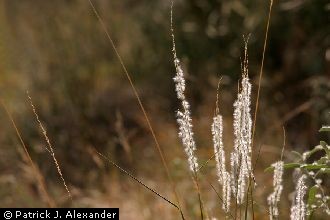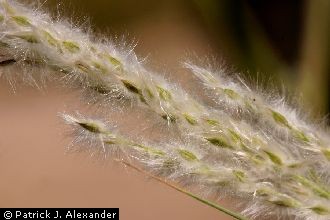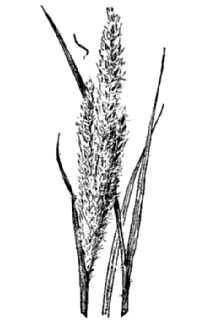Arizona Cottontop
Scientific Name: Digitaria californica (Benth.) Henr.

| General Information | |
|---|---|
| Usda Symbol | DICA8 |
| Group | Monocot |
| Life Cycle | Perennial |
| Growth Habits | Graminoid |
| Native Locations | DICA8 |
Plant Guide
Alternative Names
Common Names: cottontop, cotton-top, Arizona cottongrass, cotton grass, punta blanca, California cottontop. Scientific Names: Trichachne californica (Benth.) Chase.
Description
General: Arizona cottontop is a native, warm season perennial bunchgrass. It is 1.65 to 4.93 feet (50 to 150 cm) in height, but most commonly 1.48 to 2.96 ft (45 to 90 cm), with firm culms and a knotty base. Leaf blades are 3.94 to 5.91 inches (10 to 15 cm) long, 0.08 to 0.18 inches (2 to 4.5 mm) wide, pubescent, occasionally glabrous, flat and narrow. The ligules are 0.04 to 0.16 inches (1 to 4 mm) wide. The collars are pubescent, and the sheaths are covered with densely matted woolly hairs. The inflorescence consists of several contracted panicles that are 3.15 to 5.91 inches (8 to 15 cm) long, narrow and each containing 5 to 10 erect densely flowered branches. The spikelet is 0.12 to 0.16 inches (3 to 4 mm) wide, white (occasionally purple) and covered with abundant pubescence, giving a silky cotton-like appearance after the seed ripens (Everitt et al., 2011; Felger et al., 2014; Wasowski, 2000). Distribution: Arizona cottontop is found in the Central Great Plains, Southern Plains, Southern Plateaus, Southern Rocky Mountains, and Southwestern Desert plant growth regions (Thornburg, 1982). It is primarily present from Arizona to Texas, Colorado, the Caribbean and South America (Felger et al., 2014). For current distribution, please consult the Plant Profile page for this species on the PLANTS Web site. Habitat: Arizona cottontop is commonly found among well-drained sites, including hillsides, rocky slopes, arroyos, canyons and dry mesas (Gould, 1978; Kearney et al., 1960). It can be found in Arizona’s chaparral, oak woodland, semidesert grasslands (Mcauliffe, 1993) and broad alluvial plains in the Sonoran Desert (Cox et al., 1982). In Texas, Arizona cottontop exists on deep hard-land range sites (Brock et al., 1978), Trans-Pecos mountains and basins and south Texas plains (Alvarez & Plocheck, 2013). It is typically found at altitudes between 0 and 6,000 feet (0 to 1,820 m) (Humphrey, 1960; Judd, 1962; Maher & Reilley, 2020).
Adaptation
Arizona cottontop is adapted to low rainfall and high temperature environments (Lady Bird Johnson Wildflower Center, 2009). It is well adapted on a variety of soils from clay loam to sandy loam, but it grows best on gravelly and sandy loam soils (Leithead et al., 1971), rather than shallow, stony soils (Cable, 1979). Arizona cottontop is a long-lived grass, with some plants living 10 years or more (Martin, 1966) and it can regrow during wet years after periods of drought and after fire (Wright, 1980).
Uses
Arizona cottontop can be used in range seedings, critical stabilization and environmental protection areas (Thornburg, 1982) as it provides good cover and forage for livestock (Maher & Reilley, 2020). Since it is nearly evergreen, it works good as ground cover to prevent soil erosion (Wasowski & Wasowski, 2000). It is highly palatable forage that tolerates heavy grazing use over long periods of time (Cable & Martin, 1975). It is most palatable when green but also provides dry forage for cattle. It is mainly grazed by cattle and horses and occasionally by sheep and goats (Leithead et al., 1971), black-tailed Natural Resources Conservation Service Plant Guide 'Loetta' Arizona cottontop (Photo by Jim Thomas, USDA-NRCS Tucson Plant Materials Center). jackrabbits (Finders & Crawford, 1977) and other wildlife species including the javelina, scaled quail, mule deer, pronghorn antelope and desert cottontail (Pater & Munda, 2000).
Ethnobotany
Unknown. Other species in the genus have multiple uses including medicinal and dietary uses (Akana, 1922).
Status
Threatened or Endangered: No. Wetland Indicator: No. Weedy or Invasive: Arizona cottontop is not known to be an invasive species. Please consult the PLANTS Web site (http://plants.usda.gov/) and your state’s Department of Natural Resources for this plant’s current status (e.g., threatened or endangered species, state noxious status, and wetland indicator values).
Planting Guidelines
The recommended seeding rate for Arizona cottontop is 3-4 pure live seed (PLS) pounds per acre if planted with a drill and approximately 6-8 PLS pounds per acre if seed is broadcasted (Dial & Rosales, 2013). The seeding rate should be adjusted accordingly when used as part of a mix. There are approximately 615,000 seeds of Arizona cottontop per pound, as counted at the Tucson Plant Materials Center (Pater & Munda, 2000). Arizona cottontop reproduces primarily from seed and it can remain viable for as long as 10 years (Leithead et al., 1971). The Arizona cottontop planting period in Arizona is from late June through late August, coinciding with seasonal summer moisture (Dial & Rosales, 2013) and in August in south Texas (Maher & Reilley, 2020).
Management
Arizona cottontop grows rapidly following rainfall and continues to grow while moisture is available (Alderson & Sharp, 1994). It makes use of winter precipitation but most of its growth is produced during the summer season (Cable, 1979). Its growth is stimulated by grazing (vegetation responses). Recommendations include grazing 60 days before seed maturity every 2 to 3 years to maintain vigorous growth and limited to no more than 50% of the current year’s growth (Leithead et al., 1971).
Pests and Potential Problems
No severe insect or disease problems have been observed in Arizona cottontop once established (Maher & Reilley, 2020).
Environmental Concerns
Concerns
Concerns
None known.
Seeds and Plant Production
Plant Production , Use soil moisture sensors to measure the soil moisture of Arizona Cottontop.
Plant Production
Arizona cottontop should be planted in late summer to early fall at ¼ to ½ inch depth on a weed-free seedbed created by either tillage or herbicides. It is essential during seed development to irrigate to maintain a moist soil surface and to avoid soil crusting. Apply nutrients according to soil test results and recommendations, although established fields may require nitrogen applications each year at a rate of 40-60 pounds per acre. Appropriate herbicide can be used after the 3-5 leaf stage for weed control. Mechanical seed harvests can be completed with a combine, seed stripper or similar type harvester using a speed of 200-350 revolutions per minute. Harvested seed can be cleaned by processing with a brush machine and air screen cleaner using an 8 top screen and a 1/23 bottom screen. Alternatively, air seed shucking equipment can be used (Dial & Rosales, 2013; Pater & Munda, 2000; Maher & Reilley, 2020). Cultivars, Improved, and Selected Materials (and area of origin) Plant materials are widely available from commercial sources. Two germplasms have been released by the USDA NRCS Plant Materials Program with identified ranges of adaptation to different Major Land Resource Areas (USDA, 2006). ‘Loetta’ Germplasm Arizona cottontop (Arizona) was released from the Tucson Plant Materials Center in Tucson, Arizona. Loetta is adapted to MLRA 40 and 41, grows at a wide variety of precipitation regimes, and was collected from an area that receives approximately 11 inches of annual precipitation (Dial & Rosales, 2013). La Salle Germplasm Arizona cottontop (Texas) is a selected class from the E. “Kika” de la Garza Plant Materials Center in Kingsville, Texas. La Salle is adapted to MLRA 42, 81, 83 and 150 (Maher & Reilley, 2020; USDA, 2006). Cultivars should be selected based on the local climate, resistance to local pests, and intended use. Consult with your local land grant university, local extension, or local USDA NRCS office for recommendations on adapted cultivars for use in your area.
Literature Cited
Akana, A. (1922). Honululu: Pacific Book House. Kaaiakamanu, D. M., & Akina, J. K. Hawaiian Herbs of Medicinal Value (55). University Press of the Pacific. Alderson, J., & Sharp, W. C. (1994). Grass varieties in the United States. USDA. Alvarez, E. C., & Plocheck, R. (2013). Texas Almanac. Texas Tech Historical Association. Brock, J. H., Haas, R. H., Shaver, J. C. (1978). Zonation of Herbaceous Vegetation associated with honey mesquite in north central Texas. Society for Range Management Press. Cable, D. R., & Martin, C. S. (1975). Vegetation responses to grazing, rainfall, site condition, and mesquite control on semidesert range. USDA Forest Service. Cable, D. R. (1979). Ecology of Arizona cottontop. USDA Forest Service. Cox, J. R., Morton, H. L., & Johnson, T. N. (1982). Vegetation restoration in the Chihuahuan and Sonoran deserts of North America. USDA. Dial, H., & Rosales, M. (2013). Conservation Plant Release Brochure for ‘Loetta’ Arizona cottontop (Digitaria californica), USDA-NRCS, Tucson Plant Materials Center, Tucson, Arizona. USDA. Everitt, J., Drawe, D. L., Little, C. R., & Lonard, R. I. (2011). Grasses of South Texas: A Guide to Identification and Value. Texas Tech University Press. https://doi.org/10.3368/er.31.2.228-a Felger, R. S., Rutman, S., & Malusa, J. (2014). Ajo Peak to Tinajas Altas: A flora of southwestern Arizona Part 6. Poaceae - Grass family. The University of Arizona. Flinders, J. T., & Crawford, J. A. (1977). Composition and degradation of jackrabbit and cottontail fecal pellets, Texas High Plains. Journal of Range Management, 30(3), 217-220. Gould, F. W. (1978) Common Texas Grasses. Texas A&M University Press. Humphrey, R. R. (1970). Arizona Range Grasses. University of Arizona Press. Judd, B. I. (1962). Principal Forage Plants of Southwestern Ranges. USDA Forest Service. Kearney, T. H., Peebles, R. H., Howell, J. T., & McClintock, E. (1960). Arizona Flora, 2nd edition. University of California Press. Lady Bird Johnson Wildflower Center. (2009). Plant Database: Digitaria californica. Wildflower. https://www.wildflower.org/plants/result.php?id_plant=DICA8 Leithead, H. L., Yarlett, L. L., & Shiflet, T. N. (1971). 100 native forage grasses in 11 southern states. USDA. Maher, S., & Reilley, J. (2020). Release Brochure for for ‘La Salle’ Germplasm Arizona cottontop (Digitaria californica), USDA-NRCS, E. “Kika” de la Garza Plant Materials Center, Kingsville, Texas. USDA. Martin, C. S. (1966). The Santa Rita Experimental Range. USDA Forest Service. Mcauliffe, B. J. R. (1993). Storm over Desert Grasslands. The Sonoran Quarterly, 47(3), 1, 10. Pater, M., & Munda B. (2000). Notice of Release: ‘Loetta’ Arizona cottontop (Digitaria californica). USDA. Thornburg, A. A. (1982). Plant materials for use on surface-mined lands in arid and semiarid regions. USDA. United States Department of Agriculture (USDA). (2006). Land Resource Regions and Major Land Resource Areas of the United States, the Caribbean, and the Pacific Basin. USDA. Wasowski, S. (2000). Native landscaping from El Paso to Los Angeles. McGraw Hill Press. Wasowski, A., & Wasowski, S. (2000). The landscaping revolution garden with mother nature, not against her. Contemporary Books Press. Wright, H. A. (1980). The role and use of fire in semi-desert grass-shrub type. USDA Forest Service. Citation Thomas, G. J. (2021). Plant Guide for Arizona cottontop (Digitaria californica). USDA-Natural Resources
Conservation
Service, Tucson Plant Materials Center. Tucson, Arizona. Published September 2021 For more information about this and other plants, please contact your local NRCS field office or Conservation District at http://www.nrcs.usda.gov/ and visit the PLANTS Web site at http://plants.usda.gov/ or the Plant Materials Program web site: http://plant-materials.nrcs.usda.gov. PLANTS is not responsible for the content or availability of other Web sites.
Plant Traits
Growth Requirements
| Temperature, Minimum (°F) | -13 |
|---|---|
| Adapted to Coarse Textured Soils | Yes |
| Adapted to Fine Textured Soils | No |
| Adapted to Medium Textured Soils | Yes |
| Anaerobic Tolerance | None |
| CaCO3 Tolerance | Medium |
| Cold Stratification Required | No |
| Drought Tolerance | High |
| Fertility Requirement | High |
| Fire Tolerance | Medium |
| Frost Free Days, Minimum | 150 |
| Hedge Tolerance | None |
| Moisture Use | Low |
| pH, Maximum | 8.3 |
| pH, Minimum | 7.5 |
| Precipitation, Maximum | 14 |
| Precipitation, Minimum | 5 |
| Root Depth, Minimum (inches) | 10 |
| Salinity Tolerance | Medium |
| Shade Tolerance | Intolerant |
Morphology/Physiology
| After Harvest Regrowth Rate | Rapid |
|---|---|
| Toxicity | None |
| Shape and Orientation | Erect |
| Nitrogen Fixation | None |
| Resprout Ability | No |
| Active Growth Period | Spring and Summer |
| Bloat | None |
| C:N Ratio | Medium |
| Coppice Potential | No |
| Fall Conspicuous | No |
| Fire Resistant | No |
| Flower Color | White |
| Flower Conspicuous | No |
| Foliage Color | Green |
| Foliage Porosity Summer | Dense |
| Foliage Texture | Medium |
| Low Growing Grass | No |
| Lifespan | Short |
| Leaf Retention | No |
| Known Allelopath | No |
| Height, Mature (feet) | 4.0 |
| Growth Rate | Rapid |
| Growth Form | Bunch |
| Fruit/Seed Conspicuous | No |
| Fruit/Seed Color | Brown |
| Foliage Porosity Winter | Porous |
Reproduction
| Vegetative Spread Rate | None |
|---|---|
| Small Grain | No |
| Seedling Vigor | High |
| Seed Spread Rate | Slow |
| Seed per Pound | 1002000 |
| Fruit/Seed Persistence | No |
| Propagated by Tubers | No |
| Propagated by Sprigs | No |
| Propagated by Sod | No |
| Propagated by Seed | Yes |
| Propagated by Corm | No |
| Propagated by Container | No |
| Propagated by Bulb | No |
| Propagated by Bare Root | No |
| Fruit/Seed Period End | Fall |
| Fruit/Seed Period Begin | Summer |
| Fruit/Seed Abundance | Low |
| Commercial Availability | Field Collections Only |
| Bloom Period | Late Summer |
| Propagated by Cuttings | No |
Suitability/Use
| Veneer Product | No |
|---|---|
| Pulpwood Product | No |
| Protein Potential | Low |
| Post Product | No |
| Palatable Human | No |
| Palatable Graze Animal | High |
| Palatable Browse Animal | Medium |
| Nursery Stock Product | No |
| Naval Store Product | No |
| Lumber Product | No |
| Fodder Product | Yes |
| Christmas Tree Product | No |
| Berry/Nut/Seed Product | No |


